Priority Queues(优先级队列)
1. 优先级队列
- A priority queue is a collection of zero or more elements. Each element has a priority or value.一个优先级队列是0个或者更多元素的集合。每一个元素都有一个优先级或者值
- 进入队列的时候有优先级,出队列优先出高优先级的.
- 以下我们确定元素的优先级是通过数字的大小来确定。
1.1. 优先级队列分类(根据大小)
- In a min priority queue the find operation finds the element with minimum priority, while the delete operation delete this element.在最小优先级队列中,当需要删除一个元素的时候,我们找到优先级最小的元素来删除
- In a max priority queue, the find operation finds the element with maximum priority, while the delete operation delete this element.在最大优先级队列中,当需要删除一个元素的时候,我们找到优先级最大的元素来删除
2. 最大优先级队列(MaxPriorityQueue)
2.1. ADT(逻辑上最大优先级队列)
AbstractDataType MaxPriorityQueue
{
instances
finite collection of elements,each has a priority 有限的元素的结合,每个元素都有一个优先级
operations
Create(): create an empty priority queue 创建一个空的优先级队列
Size(): return number of element in the queue 返回队列中元素的个数
Max(): return element with maximum priority 返回队列中拥有最高优先级的元素
Insert(x): insert x into queue 插入x进入队列
DeleteMax(x):delete the element with largest priority from the queue; return it in x;删除队列中最高优先级的元素,并且通过x返回它
}
实现
Use an unordered linear list 我们使用无序线性表来进行实现
Insertions are performed at the right end of the list, θ(1) 插入元素到链表的最右边(时间复杂度为常数)
A deletion requires a search for the element with largest priority, θ(n)(需要查找到最高优先级的元素并且删除这个元素)
2.2. 物理实现:Heap
- A max heap(min Heap):(最大堆)
- is A complete binary tree 最大堆是一个完全二叉树
- The value in each node is greater(less) than or equal to those in its children(if any).每一个节点上的值都大于(小于)或者等于他的子节点(如果有的话)
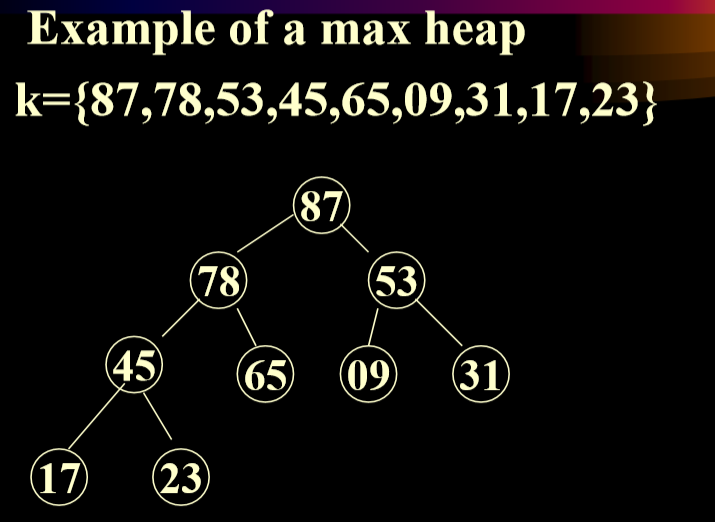
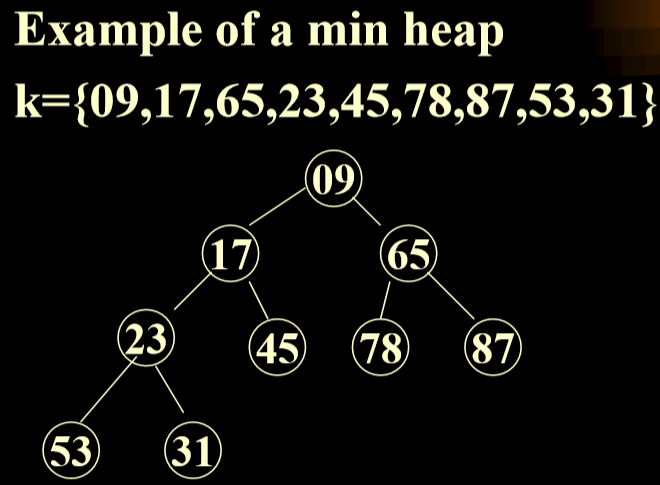
- 注意:完全二叉树可以用矩阵来进行存储。
- 从上向下一层一层进行记录。
2.3. 实现:最大优先级队列
template<class T>class MaxHeap
{
public:
MaxHeap(int MaxHeapSize=10);
~MaxHeap(){delete[]heap;}
int size()const{return CurrentSize;}
T Max(){
if (CurrentSize==0) throw OutOfBounds();
return heap[1];
}
MaxHeap<T>&insert(const T&x);
MaxHeap<T>& DeleteMax(T& x);
void initialize(T a[], int size, int ArraySize);
private:
int CurrentSize, MaxSize;
T * heap;
}
- 数组0号位置不用,也就是从Heap[1]开始使用
2.3.1. 最大堆的构造方法
template<class T> MaxHeap<T>::MaxHeap(int MaxHeapSize) {
MaxSize=MaxHeapSize;
Heap = new T[MaxSize+1];
CurrentSize=0;
}
2.3.2. 最大堆的插入算法
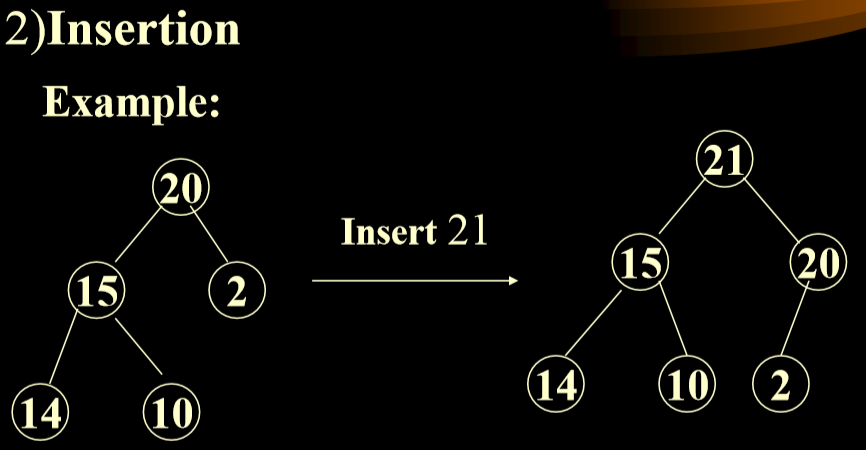
- 在数组后面插入后,和其父结点进行比较,如果比父结点大,则交换,一直到不再大于其父结点。
- 注意在最大优先级队列中的优先交换大的子树,不然会造成重复滤过。
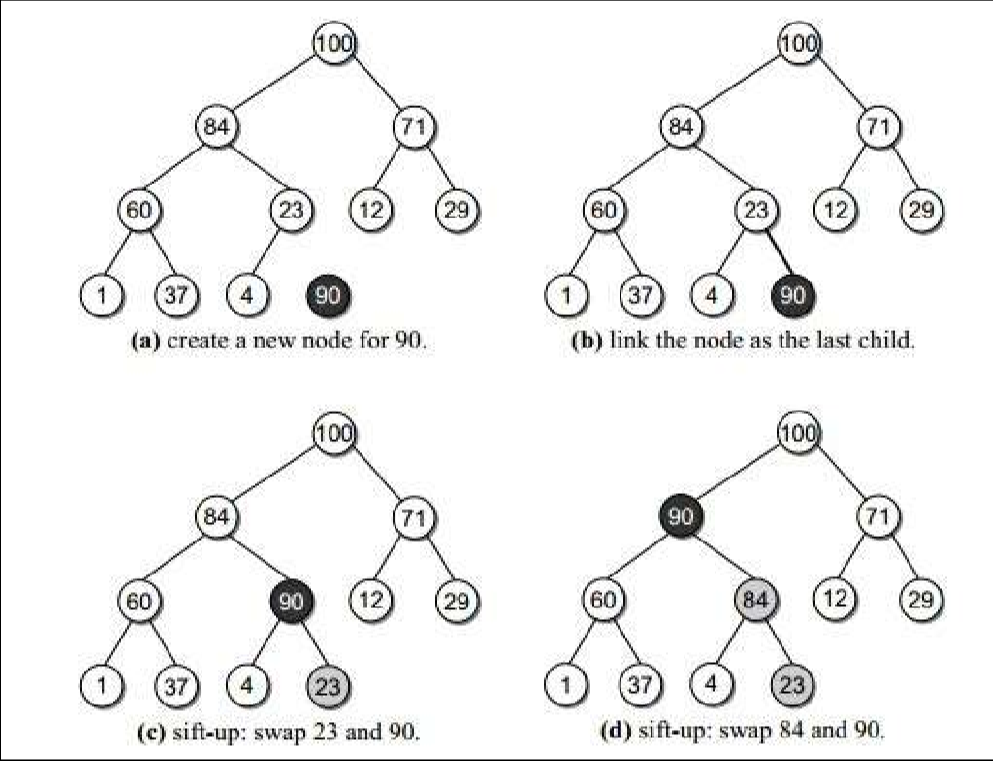
- 插入算法的时间复杂度:log2(n)
template<class T>MaxHeap<T>& MaxHeap<T>:: Insert(const T& x){
if(CurrentSize= =MaxSize) throw NoMem();
int i=++CurrentSize;
while(i!=1&&x>heap[i/2]){
//0不使用
heap[i]=heap[i/2];
//不必每次都进行完全交换
i/=2;
}
heap[i]=x;
return *this;
}
2.3.3. 最大堆的删除算法

- 将根删除,将数组最后一个(最后一层最后一个元素)换为根,然后进行比较。
template<class T>MaxHeap<T>& MaxHeap<T>:: DeleteMax(T& x){
if(CurrentSize==0) throw OutOfBounds();
x = heap[1];
//0无存储,这个就是root结点
T y=heap[CurrentSize--];
int i=1;//i标向树根
ci=2;//ci先标到左子树
while(ci<=CurrentSize){
if(ci<CurrentSize && heap[ci]<heap[ci+1])//如果ci未越界,并且左子树的值小于右子树的值。
ci++;//转向右子树
if(y>=heap[ci]) break;
heap[i]=heap[ci];
i=ci;
ci*=2;
}
heap[i]=y;//y是最后一个节点
return *this;
}
- 插入算法的时间复杂度:log2(n)
2.4. 初始化一个非空的最大优先级数列
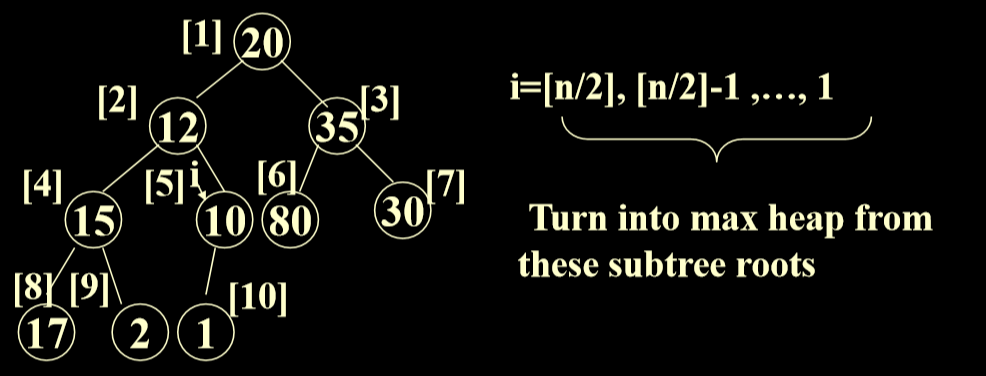
- 把初始指针指向最后一个节点的父结点(N/2)
- 然后进行循环,然后每一个都换一遍就完成。
- 总体来讲是从最后一个节点的父结点开始,对所有的非叶节点进行下滤操作。
- 对于某一层节点进行下滤后,对其父结点继续进行下滤。
//C++
//注意是对每个子树进行递归处理
Template<class T> void MaxHeap<T>::Initialize (T a[],int size,int ArraySize) {
delete[] heap;
heap=a;
CurrentSize=Size;
MaxSize=ArraySize;
for( int i=CurrentSize/2; i>=1; i--) {
T y=heap[i];
int c=2*i;
while(c <= CurrentSize){
if(c<CurrentSize && heap[c]<heap[c+1])
c++;
if(y>=heap[c])
break;
heap[c/2] = heap[c];
c*=2;
//找到其子节点位置
}
heap[c/2]=y;
}
}
// java 实现最大堆
private void buildHeap(){
for( int i = currentSize / 2; i > 0 ; i-- )
percolateDown(i);
}
- 已经在内存中的算法复杂度分析(直接交换调整)
- 对于不同层的节点,其下滤的计算量时不同的
- 如何从感觉上立即这个问题:在数据的开始是不会到lgn的,而只有到后面的时候才能达到lgn(lgn = log2n)
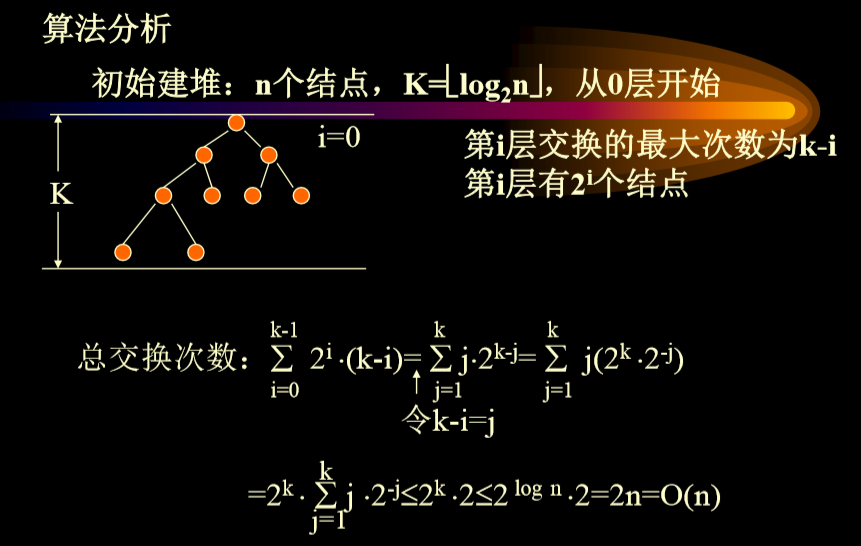
- 不在内存(插入)中的算法复杂度分析(需要上滤)(需要进行其他操作调整)
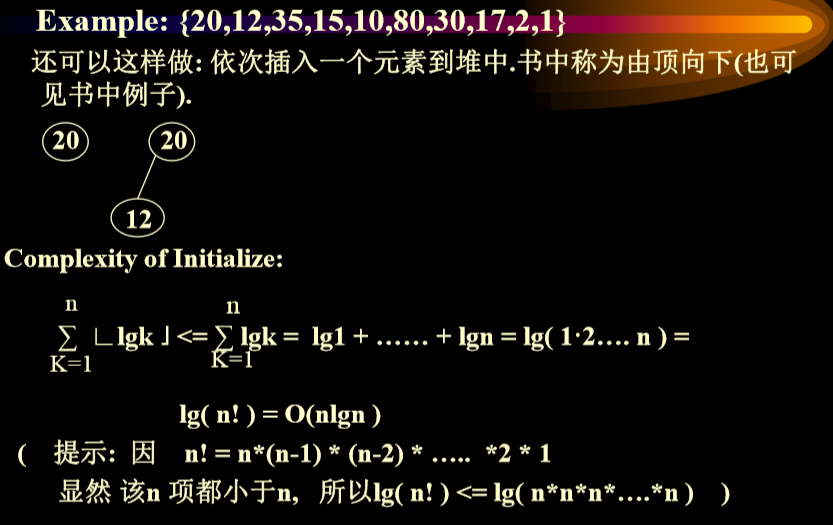
3. 实现最小优先级队列
public class BinaryHeap {
public BinaryHeap( )
public BinaryHeap( int capacity )
public void insert( Comparable x ) throws Overflow()
public Comparable findMin( )
public Comparable deleteMin( )
public boolean isEmpty( )
public boolean isFull( )
public void makeEmpty( )
private static final int DEFAULT_CAPACITY = 100
private int currentSize
private Comparable [ ] array;
private void percolateDown( int hole )
private void buildHeap( )
}
public BinaryHeap(){
this( DEFAULT_CAPACITY );
}
public BinaryHeap( int capacity ) {
currentSize = 0;
array = new Comparable[ capacity + 1 ];
}
public void makeEmpty( ) {
currentSize = 0;
}
//最小堆的插入算法
public void insert( Comparable x ) throws Overflow() {
if(isFull()) throw new Overflow();
int hole = ++currentSize;
for(;hole>1 && x.comparebleTo(array[hole/2])<0;hole/= 2){
array[hole] = array[hole / 2];
}
array[ hole ] = x;
}
- 插入实例
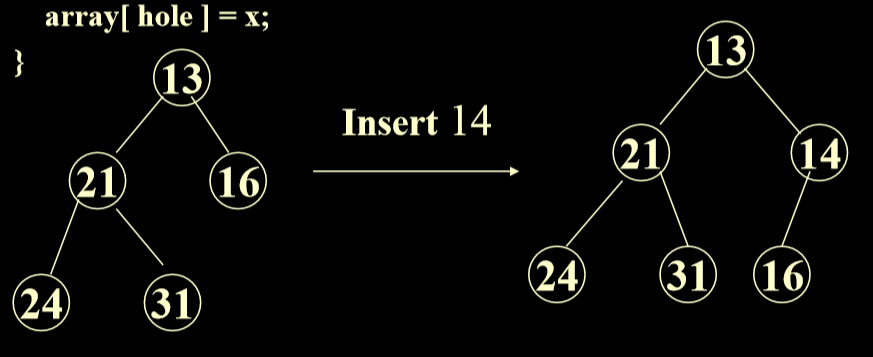
public Comparable deleteMin(){
if( isEmpty()) return null;
Comparable minItem = findMin( );
array[1] = array[currentSize--];
percolateDown(1);
return minItem;
}
//最小堆的,将最高顶部的元素向下传动,下滤算法
private void percolateDown(int hole) {
int child;
Comparable tmp = array[hole];
for(;hole*2<=currentSize;hole = child) {
child = hole * 2;//切入到左子树
if(child!=currentSize && array[child+1 ].compareTo(array[child])<0)
child++;//如果没有到头,并且右子树比左子树小,则转向右边的子树
if(array[child].compareTo(tmp)<0)
array[hole] = array[child];//如果小则进行交换
else
break;
}
array[hole] = tmp;
}
- 删除实例

3.1. 参考
4. 优先级队列的应用
4.1. 堆排序(容易考)
- initialize a max heap with the n elements to be sorted O(n) 初始化一个n个元素的最大堆,O(n)
- each time we delete one element, then adjust the heap O(log2n) 每次我们删除最大的元素,调整堆的时间复杂度为O(log2n)
- Time complexity is O(n)+O(nlog2n)=O(nlog2n)
- 例子:{21,25,49,25*,16,08}
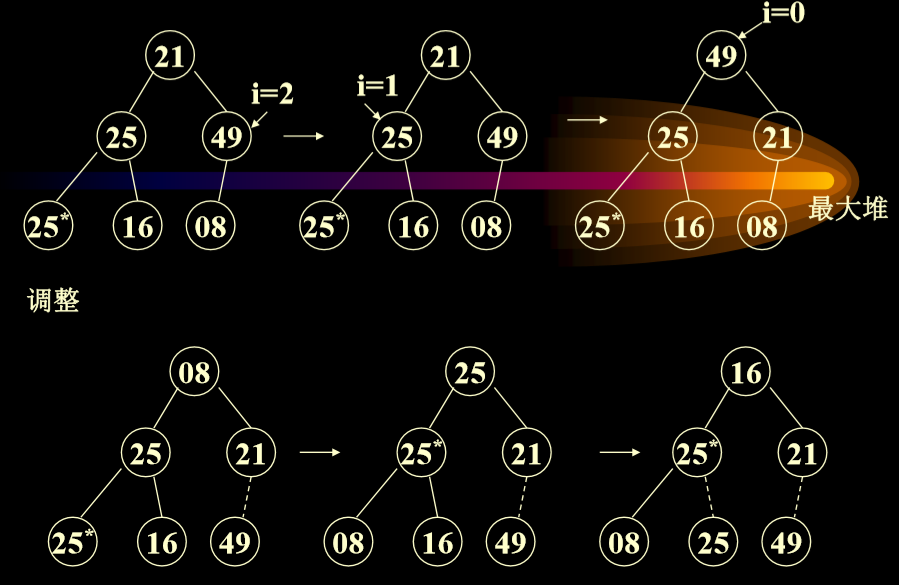
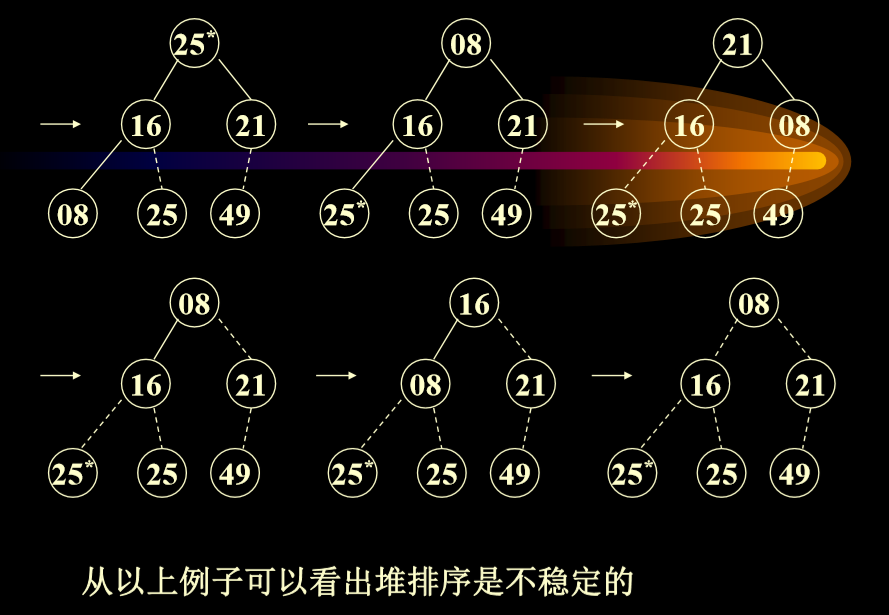
- 堆排序是不稳定的:因为相同数据的位置不同
- 堆排序每次删除最大的,然后把最大的放到最下方节点,把节点交换到顶部后进行下滤算法。
//c++
Template<class Type>void HeapSort(datalist<Type>&list){
for(int i=(list.currentsize)/2;i>=1;i--)
FilterDown(i,list.currentsize);
for(i=list.currentsize; i>1 ;i--){
Swap(list.Vector[1],list.vector[i]);
FilterDown(1,i-1);
}
}
public static void heapsort( Comparable [] a ) {
for( int i = a.length / 2; i >= 1; i-- )
percDown( a, i, a.length );
for( int i = a.length ; i > 1; i-- ) {
swapReferences(a,1,i);
percDown(a,1,i-1);
}
}
private static void percDown( Comparable [] a, int i, int n ) {
int child;
Comparable tmp;
for( tmp = a[ i ]; leftChild( i ) < n; i = child ) {
child = leftChild( i );
if( child != n – 1 && a[child ].compareTo( a[ child + 1 ]) < 0 )
child++;
if( tmp.compareTo( a[ child ] ) < 0 )
a[ i ] = a[ child ];
else break;
}
a[ i ] = tmp;
}
private static int leftChild( int i ) {
return 2 * i + 1;
}
4.2. The Selection Problem 查找问题
- 问题描述:在N个元素中找出第K个最大元素。
- 1A算法:读入N个元素放入数组, 并将其选择排序,返回适当的元素。算法时间复杂度:O( N2)
- 1B算法:
- 将K个元素读入数组,并对其排序(按递减次序)。最小者在第K个位置上。
- 一个一个地处理其余元素:每读入一个元素与数组中第K个元素(在K个元素中为最小)比较,如果大于,则删除第K个元素,再将该元素放在合适的位置上(调整过程)。如果小于, 则舍弃。最后在数组K位置上的就是第K个最大元素。
- 运行时间(1B 算法): O(K2 + (N - K)K ) = O( NK ) 当 K = N / 2(向上取整), O( N2 )
- 例如:3, 5, 8, 9, 1, 10,找第3个最大元素。
4.2.1. 用堆来解决当前问题
- 6A算法:假设求第K个最小元素
- 将N个元素建堆(最小)O( N )
- 执行K次delete,O( K*logN ) O( N + K * log N )
- 如果 K = (N/2)(向上取整),O( N * log N )
- 如果 K = N ,O( N * log N ) 堆排序
- 如果是N取代最后一个是nlgn,可以考虑使用不同的情况来确定建立最大堆还是最小堆。
- 6B算法:假设求第K个最大元素
- 读入前K个元素, 建立最小堆O( K )
- 其余元素一一读入:每读入一个元素与堆中第K个最大元素比(实际上是堆中最小元素)O(1)
- 大于,则将小元素去掉(堆顶),该元素进入,进行一次调整。O(log K )
- 小于,则舍弃。
- O( K + ( N-K) * log K ) = O( N*log K)
- 当 K = (N/2)(向上取整) , θ(N * log N )
- 对6A, 6B,用同样的数据进行测试, 只需几秒钟左右给出问题解。
5. 例题:2009统考题

- 答案:A
- 直接按照顺序一行一行生成。
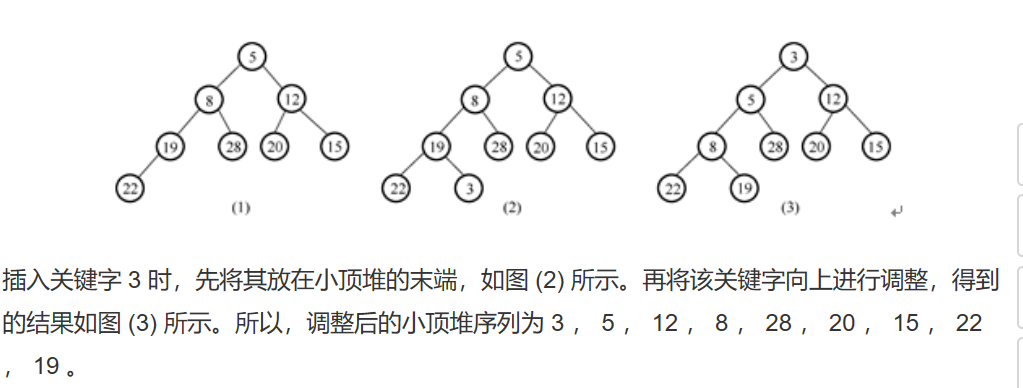






















 147
147











 被折叠的 条评论
为什么被折叠?
被折叠的 条评论
为什么被折叠?








